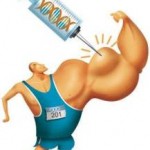Even when the body is able to maintain core body temperature, cardiovascular performance is decreased in the heat.
 Researchers from the American College of Sports Medicine conducted research in January 2010 that shows that environmental heat stress with only modest hyperthermia has a significant impact on aerobic endurance. This research is of importance to a military operating in a desert environment in which temperatures can exceed 120˚ F in the summer.
Researchers from the American College of Sports Medicine conducted research in January 2010 that shows that environmental heat stress with only modest hyperthermia has a significant impact on aerobic endurance. This research is of importance to a military operating in a desert environment in which temperatures can exceed 120˚ F in the summer.
Subjects were asked to perform fifteen minutes of cycling in a temperate (69˚F) or hot environment (104˚F). Core and skin temperature and heart rate were constantly monitored. Performance and pacing were analyzed by kJ of work completed. Core temperature was modestly elevated in both environments, with skin temperature being higher in the hot environment. While heart rate and fatigue level were consistent between the two environments, the total amount of work done in the hot environment was 17% less than in the temperate environment. Also, while the pace was maintained in the temperate climate, it dropped significantly over time in the hot environment.
So, although excessive hyperthermia was avoided, performance was still impacted by the hot environment. While it has been established that marked hyperthermia leads to increased fatigue during exercise, it seems that a hot environment can increase fatigue even without significant increase in core temperature. There are a few theories about how this happens. One idea is that athletes use an anticipatory control mechanism during exercise to ensure maintenance of core body temperature by making unconscious adjustments in work rate. Increased cardiovascular strain resulting from the maintenance of high skin blood flow required to maintain core temperature may also explain the observed decrease in performance. So, impact aerobic ability in the heat may come from either an early modification of work output or an inability to maintain a desired work output over time. This study supported the idea that initial pace could not be maintained, as the participants in the hot group got much slower over time.
It seems clear that cardiovascular performance is decreased in the heat even when the body is able to maintain core temperatures. Further research may elucidate whether an early modification of pace in the heat may minimize the overall decline in performance associated with environmental heat stress. This information can help athletes who must compete in the heat to pace themselves, and may also shed light on tactics the military can use to maintain optimum performance in hot climates.
Nicole Myers
For more information visit: http://www.dtic.mil/cgi-bin/GetTRDoc?AD=ADA513059&Location=U2&doc=GetTRDoc.pdf

